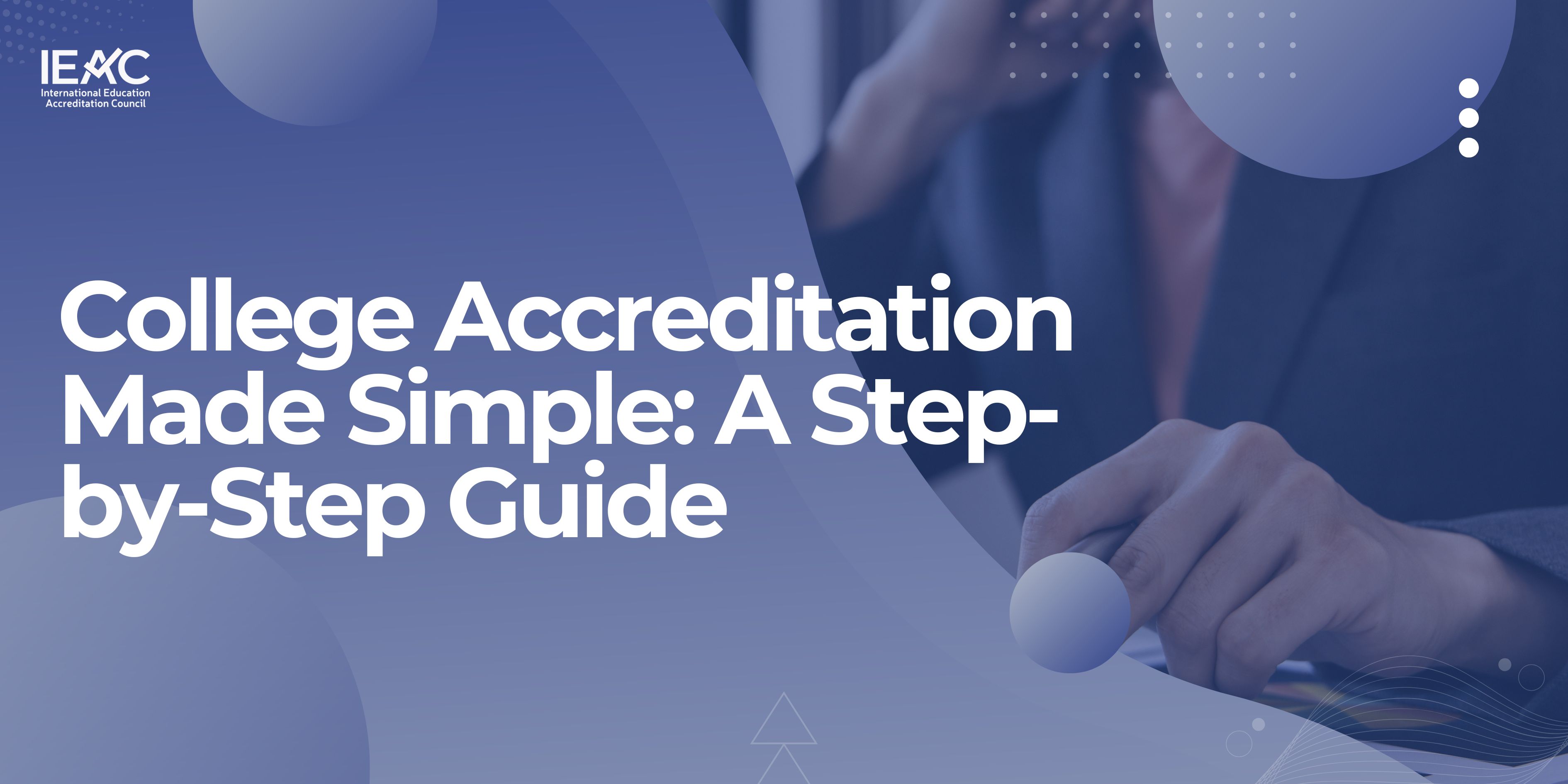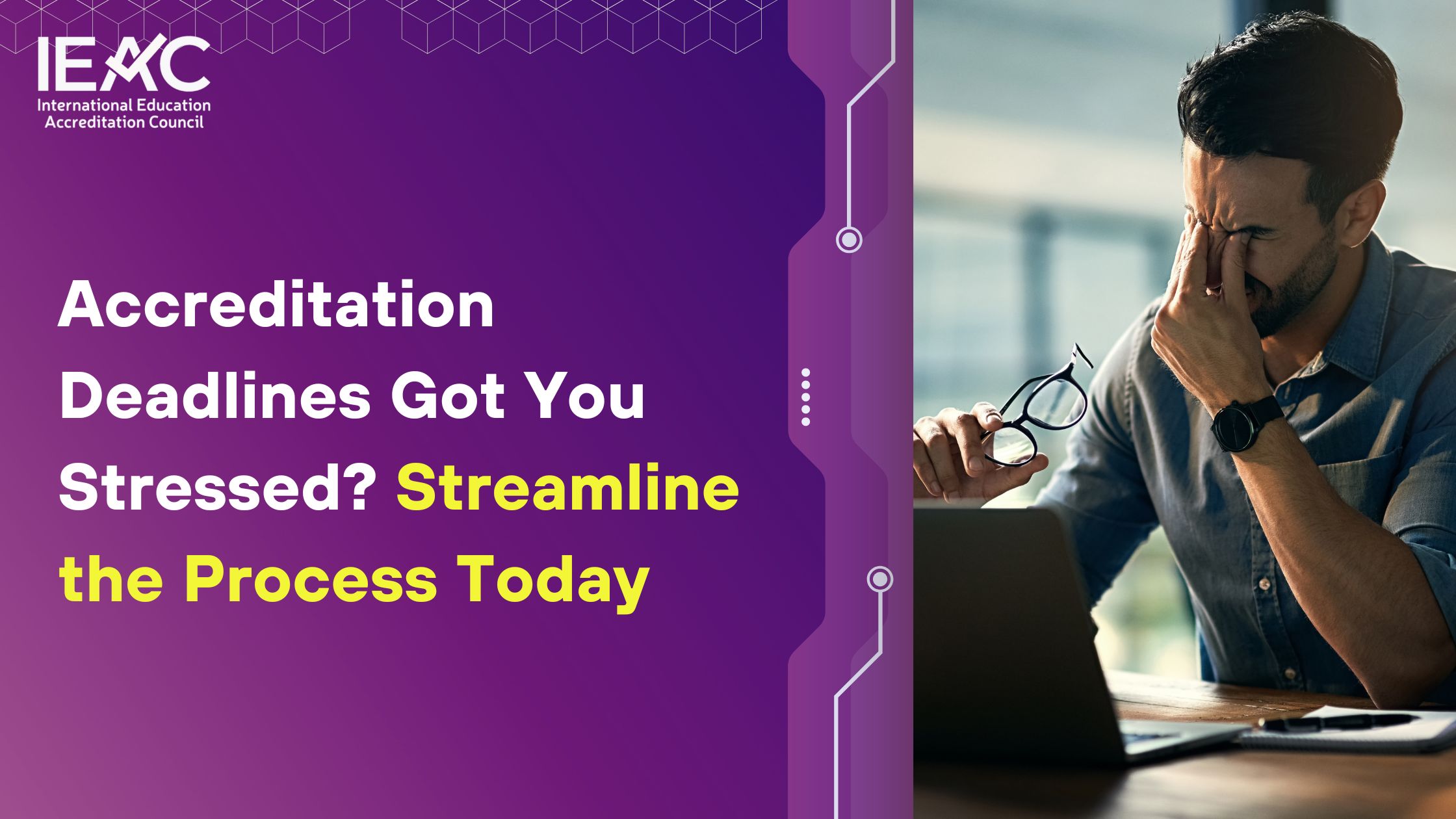- Home
- About IEAC
- Accreditation
- University Accreditation
- College Accreditation
- Online Institution Accreditation
- School Accreditation
- University Recruitment Agency Accreditation
- Programmatic Accreditation
- Teacher/ Lecturer Accreditation
- Religious Institutes Accreditation
- Affiliate Accreditation
- Research Accreditation Candidacy Accreditation
- IEAC Membership
- Institutions Accredited
- Accreditation Process
- Contact Us Webinar Apply Now
Blog
College Accreditation Made Simple: A Step-by-Step Guide
Lorem ipsum dolor sit amet, consectetur adipiscing elit, sed do eiusmod tempor incididunt ut labore et dolore magna aliqua. Quis ipsum suspendisse ultrices gravida. Risus commodo viverra maecenas accumsan lacus vel facilisis.

College Accreditation Made Simple: A Step-by-Step Guide
In higher education, college accreditation is more than a seal of approval—it’s a formal recognition that an institution meets defined standards of academic quality and operational excellence. Accreditation validates the institution’s commitment to providing high-quality education and reassures students, parents, and employers of its credibility.
For institutions, the process creates a framework for continuous improvement by identifying curriculum gaps, encouraging innovative teaching methods, and aligning academic outcomes with industry demands. For students, it ensures a robust learning experience that prepares them for the workforce. For colleges, it enhances reputation, attracts enrollments, and fosters long-term growth.
So, how can colleges and online institutions navigate the rigorous journey of accreditation successfully? Let’s break it down into effective, actionable tactics.
Step 1: Conduct a Comprehensive Self-Assessment
The accreditation journey begins with introspection. A self-assessment allows colleges to critically analyze their current academic, administrative, and operational practices against the benchmarks set by accrediting agencies.
This involves:
- Reviewing the quality of academic programs to ensure they meet learning outcome expectations.
- Evaluating administrative systems for efficiency, transparency, and compliance.
- Measuring student support services, such as counseling, career services, and extracurricular opportunities.
- Auditing facilities, teaching resources, and digital infrastructure.
Colleges should use data-driven tools like faculty and student surveys, graduation statistics, and performance dashboards to identify gaps. For online institution accreditation, this also means assessing digital platforms for accessibility, user experience, and compliance with international e-learning standards.
A well-executed self-assessment not only highlights strengths but also provides a roadmap for targeted improvements.
Step 2: Establish a Dedicated Accreditation Team
Accreditation is too large a task for one person or department to handle. Setting up a dedicated accreditation team ensures coordinated efforts and collective responsibility.
This team usually consists of:
- Faculty members to review academic quality and curricula.
- Administrative staff to oversee compliance and documentation.
- IT specialists to manage digital data and systems, especially in online institutions.
- Student representatives to provide feedback from the learner’s perspective.
The team’s responsibilities include creating an accreditation timeline, aligning goals with standards, and monitoring progress. Regular meetings help maintain accountability and foster cross-department collaboration. For institutions seeking college accreditation, the presence of such a team demonstrates organizational commitment to excellence.
Step 3: Gather Essential Documentation
No accreditation process can succeed without thorough and accurate documentation. Accrediting bodies rely on evidence to evaluate whether an institution meets quality standards.
Key documents include:
- Program and course outlines showing alignment with learning outcomes.
- Faculty credentials and professional development records.
- Student academic records, graduation rates, and placement statistics.
- Strategic plans and previous evaluation reports.
- Financial management and governance records.
Institutions should maintain digital repositories to store and organize this information. For online institution accreditation, additional documentation may include LMS performance reports, student access logs, and data security compliance records.
Organized documentation not only makes the external review process smoother but also reflects institutional discipline and professionalism.
Step 4: Leverage Technology in the Accreditation Process
In today’s academic environment, technology plays a crucial role in institutional accreditation. It reduces manual workload, increases accuracy, and enables real-time tracking of quality indicators.
- Curriculum Assessment Tools
Colleges can adopt digital systems to evaluate curriculum relevance, track student outcomes, and align programs with industry needs. These tools help identify gaps and ensure courses remain rigorous and up to date.
- Accreditation Management Systems (AMS)
An AMS centralizes workflows, timelines, and compliance tasks. It allows institutions to:
- Monitor accreditation readiness.
- Generate automated compliance reports.
- Assign roles and manage secure access across departments.
- Maintain transparency and accountability.
- Data Analytics & Reporting Software
Dashboards powered by analytics tools provide actionable insights into institutional strengths and weaknesses. They can show real-time metrics such as student satisfaction rates, graduation statistics, and faculty performance.
By adopting such systems, colleges, especially those pursuing online institution accreditation, can streamline their accreditation journey while creating a culture of evidence-based decision-making.
Step 5: Commit to Continuous Improvement
Accreditation is not the end, it’s the beginning of an ongoing process of growth. To retain accredited status, institutions must commit to continuous improvement.
This means:
- Curriculum revisions: Regularly updating courses to reflect new research, technologies, and workforce demands.
- Feedback integration: Using online surveys, focus groups, and performance reviews to shape academic offerings.
- Innovative teaching methods: Incorporating e-learning tools, blended classrooms, gamification, and project-based learning.
- Faculty development: Encouraging teachers to pursue professional certifications, attend workshops, and adopt new pedagogies.
For college accreditation, continuous improvement demonstrates commitment to students’ long-term success. For online institutions, it ensures that digital learning platforms evolve with learner expectations and technological advancements.
Benefits of Accreditation for Institutions and Stakeholders
The impact of accreditation goes beyond compliance, it brings measurable benefits for all stakeholders:
- Students: Gain confidence in the value of their education, access better career opportunities, and enjoy smoother credit transfers for higher studies.
- Parents: Reassurance that their investment is directed toward a credible, quality institution.
- Employers: Confidence in hiring graduates who are industry-ready and trained to global standards.
- Colleges: Enhanced reputation, increased enrollment, global recognition, and eligibility for partnerships and funding opportunities.
- Stakeholders: Improved planning, resource allocation, and transparency in decision-making.
In particular, online institution accreditation helps digital platforms gain credibility in the competitive global education market, reassuring learners that their programs meet the same standards as traditional colleges.
A Roadmap to Academic Excellence
Achieving college accreditation is a demanding process that requires strategic planning, collaboration, and technology integration. From conducting self-assessments and building dedicated teams to leveraging digital systems and ensuring continuous improvement, institutions can navigate this journey effectively.
Accreditation is more than recognition, it’s a promise of excellence. It strengthens the institution’s identity, empowers faculty and staff, and assures students and stakeholders of high academic standards. By embracing best practices and innovative systems, colleges, both traditional and online, can position themselves as leaders in education, fully prepared to meet the demands of an evolving global workforce.
Frequently Asked Questions (FAQs)
1. What is college accreditation, and why is it important?
College accreditation is a formal recognition that an institution meets defined standards of quality in academics, governance, and student services. It assures students, parents, and employers that the education provided is credible, effective, and aligned with industry requirements.
2. What is the difference between institutional accreditation and program accreditation?
- Institutional Accreditation evaluates the entire college or university to ensure it meets overall standards of excellence.
- Program Accreditation focuses on specific programs (like Engineering, Business, or Nursing) to confirm they meet the requirements of their profession.
3. Why do online institutions need accreditation?
Online institution accreditation validates the quality of digital education programs. It reassures learners that online courses meet the same standards as traditional on-campus programs, ensuring credibility and acceptance by employers or other universities.
4. How long does the accreditation process take?
The timeframe can vary, but college accreditation typically takes 1–3 years, depending on the institution’s readiness, the accrediting body, and the scope of programs reviewed. Continuous improvement and documentation can shorten this timeline.
5. What happens if a college loses accreditation?
Losing accreditation can affect a college’s reputation, student enrollment, and funding opportunities. Students may face challenges transferring credits or securing jobs. That’s why institutions must commit to ongoing compliance and quality assurance.
6. How can technology support the accreditation process?
Technology plays a major role by:
- Automating curriculum assessments.
- Storing and organizing accreditation documents.
- Using data analytics for performance tracking.
- Offering Accreditation Management Systems (AMS) for real-time compliance monitoring.
7. Who benefits from accreditation the most?
Everyone involved:
- Students gain access to quality education and career opportunities.
- Colleges build credibility and global recognition.
- Employers trust the skills of accredited graduates.
Parents and stakeholders gain confidence in institutional performance.


.jpg)


